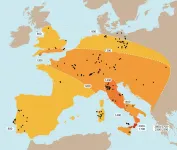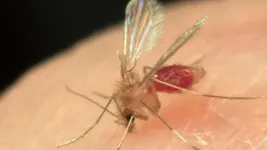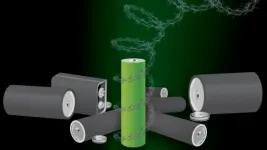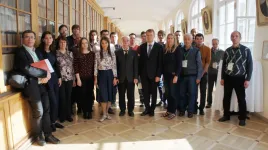Scrap for cash before coins
Researchers including Göttingen University show Bronze Age witnessed revolution in small change across Europe
2021-05-06
(Press-News.org) How did people living in the Bronze Age manage their finances before money became widespread? Researchers from the Universities of Göttingen and Rome have discovered that bronze scrap found in hoards in Europe circulated as a currency. These pieces of scrap - which might include swords, axes, and jewellery broken into pieces - were used as cash in the late Bronze Age (1350-800 BC), and in fact complied with a weight system used across Europe. This research suggests that something very similar to our 'global market' evolved across Western Eurasia from the everyday use of scrap for cash by ordinary people some 1000 years before the beginning of classical civilizations. The results were published in Journal of Archaeological Science.
This study analysed around 2,500 metal objects and fragments from among the thousands of hoards of fragments from the late Bronze Age that, over time, have been unearthed in Central Europe and Italy. The researchers used a statistical technique that can determine if a sample of measurements is due to an underlying system. This technique can detect, for instance, if the analysed objects are multiples of a weight unit. The researchers' analysis provides very significant results for fragments and scraps, which means that these metal objects were intentionally fragmented in order to meet predetermined weights. The analyses confirm that the weight unit that regulated the mass of metals was the same unit represented in European balance weights of the same period. The researchers conclude that these scraps were being used as money, and that the fragmentation of bronze objects was aimed at obtaining 'small change' or cash.
Trade in prehistory is commonly imagined as a primitive system based on barter and on the exchange of gifts, with money appearing as some kind of evolutionary milestone somewhere during the making of Western state-societies. The study challenges this notion by introducing the concept that money was a bottom-up convention rather than a top-down regulation. Bronze Age money in Western Eurasia emerges in a socio-political context in which public institutions either did not exist (as was the case in Europe) or were uninterested in enforcing any kind of monetary policy (as in Mesopotamia). In fact, money was widespread and used on a daily basis at all levels of the population.
The spread of the use of metallic scraps for cash happened against the background of the formation of a global market in Western Eurasia. "There was nothing 'primitive' about pre-coinage money, as money before coins performed exactly the same functions that modern money does now," explains Dr Nicola Ialongo at the University of Göttingen's Institute for Prehistory and Early History. Ialongo adds, "Using these metallic scraps was not an unexpected development, as it is likely that perishable goods were used as currency long before the discovery of metallurgy, but the real turning point was the invention of weighing technology in the Near East around 3000 BC. This provided, for the first time in human history, the objective means to quantify the economic value of things and services, or, in other words, to assign them a price."
INFORMATION:
The study is the result of an international collaboration between the project 'Weight and Value' at the University of Göttingen and directed by Professor Lorenz Rahmstorf, and Sapienza University of Rome.
Original publication: Ialongo, N., Lago, G. 2021. A small change revolution. Weight systems and the emergence of the first Pan-European money. Journal of Archaeological Science 129. DOI: 10.1016/j.jas.2021.105379
Contact
Dr Nicola Ialongo
University of Göttingen
Faculty of Humanities
Institute for Prehistory and Early History
Nikolausberger Weg 15, 37073 Göttingen
Tel: +49 (0)551 25078
nicola.ialongo@uni-goettingen.de
[Attachments] See images for this press release:

ELSE PRESS RELEASES FROM THIS DATE:
2021-05-06
'Natural disasters,' sparked by climate change and other natural hazards, increase the triggers for violence against women and girls by boosting the means, opportunity, and underlying drivers, finds a review of the available evidence, published in the online journal BMJ Global Health.
As these disasters are increasing in frequency, severity, and duration worldwide, this consequence must now be formally recognised in public health, violence prevention, and disaster management strategies, urge the researchers.
Over the past two decades, 7348 ...
2021-05-06
New research from Simon Fraser University suggests that students learning remotely become night owls but do not sleep more despite the time saved commuting, working or attending social events.
The study, led by psychology professor Ralph Mistlberger, Andrea Smit and Myriam Juda, at SFU's Circadian Rhythms and Sleep Lab, compared self-reported data on sleep habits from 80 students enrolled in a 2020 summer session course at SFU with data collected from 450 students enrolled in the same course during previous summer semesters. The study results were recently published in the journal PLOS ONE.
"There is a widespread belief among ...
2021-05-06
In a study published today in the Journal of the American Medical Association (JAMA), Johns Hopkins Medicine researchers show that although two doses of a vaccine against SARS-CoV-2 -- the virus that causes COVID 19 -- confers some protection for people who have received solid organ transplants, it's still not enough to enable them to dispense with masks, physical distancing and other safety measures.
This is a follow-up study to an earlier one published in March in JAMA, in which the researchers reported that only 17% of the participating transplant recipients produced sufficient antibodies after just one dose of a two-dose COVID-19 vaccine regimen.
"While there was an ...
2021-05-06
Loneliness and social isolation have been significant problems for the general population during the COVID-19 pandemic, but for cancer patients these issues were particularly acute, likely due to isolation and social distancing, according to a new UCSF study.
The study, which is the first to evaluate loneliness, anxiety, depression, fatigue and other symptoms in a single group of patients, is published in Cancer, a peer-reviewed journal of the American Cancer Society.
"We found that oncology patients were experiencing a deep sense of loneliness," ...
2021-05-06
Researchers at North Carolina State University and the University of North Carolina Greensboro made a surprising finding while examining areas where sand flies rear their young: a new species of bacteria that is highly attractive to pregnant, or gravid, sand flies. The findings could advance the production of ecologically safe baits or traps to reduce sand fly populations.
Sand flies are vectors for important parasitic diseases affecting people in tropical and subtropical regions in Asia, Africa and the Middle East. One of those diseases is Leishmaniasis, which generally causes ...
2021-05-06
HOUSTON - (May 6, 2021) - A Rice University laboratory has adapted its laser-induced graphene technique to make high-resolution, micron-scale patterns of the conductive material for consumer electronics and other applications.
Laser-induced graphene (LIG), introduced in 2014 by Rice chemist James Tour, involves burning away everything that isn't carbon from polymers or other materials, leaving the carbon atoms to reconfigure themselves into films of characteristic hexagonal graphene.
The process employs a commercial laser that "writes" graphene patterns into surfaces that to date have included wood, paper and even food.
The new iteration writes fine patterns of graphene into photoresist polymers, light-sensitive materials used in photolithography and ...
2021-05-06
As the human body's largest organ, the skin is responsible for protecting against a wide range of possible infections on all fleshy surfaces, from head to toe. So how exactly does the skin organize its defenses against such an array of threats?
A new Yale study shows that the epidermis, the outermost layer of skin, is comprised of an army of immune cells that station themselves at regular intervals across the skin's vast expanse to resist infection. When necessary, the researchers found, these immune system soldiers are able to reposition themselves to protect vulnerable areas.
The study, published in the journal Nature Cell Biology, was conducted by the lab of Valentina ...
2021-05-06
The introduction of lithium-ion (Li-ion) batteries has revolutionized technology as a whole, leading to major advances in consumer goods across nearly all sectors. Battery-powered devices have become ubiquitous across the world. While the availability of technology is generally a good thing, the rapid growth has led directly to several key ethical and environmental issues surrounding the use of Li-ion batteries.
Current Li-ion batteries utilize significant amounts of cobalt, which in several well-documented international cases is mined using child labor in dangerous working ...
2021-05-06
The idea of creating quantum computers has long captured the minds of researchers and experts of IT corporations. They are the most powerful computers operating according to the laws of the quantum world and capable of solving many problems more efficiently than the most productive classical supercomputers. Similar developments are underway, for example, at Google and IBM. However, many such projects require the use of cryostats. These are vessels with liquid nitrogen or compressed helium, inside which quantum processors are cooled to temperatures below -270°C. Such a low temperature is required to maintain the superconductivity effect, which is necessary for the operation ...
2021-05-06
Today's 10,000 species of birds live in virtually every habitat on Earth, but only a handful have adaptations enabling them to hunt active prey in the dark of night. Scientists have long wondered whether theropod dinosaurs - the group that gave rise to modern birds - had similar sensory adaptations.
A new study led by University of the Witwatersrand scientist, Professor Jonah Choiniere, sought to investigate how vision and hearing abilities of dinosaurs and birds compared. The international team of researchers used CT scanning and detailed measurements to collect information ...
LAST 30 PRESS RELEASES:
[Press-News.org] Scrap for cash before coins
Researchers including Göttingen University show Bronze Age witnessed revolution in small change across Europe






